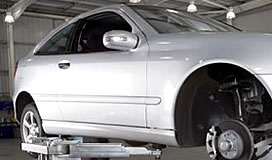|
|
|
Your Car and the MOT Test... |
|
|
|
|
| Any car registered for use on the road in the EC must pass some kind of mechanical and emissions test – known in the UK as the 'MOT', after the old Ministry of Transport. In the UK cars must be Tested at the end of their third year (if imported, measured from date of manufacture), and yearly after that |
|
| If you have a car that is more than 3 years old it will need an MOT test each year to ensure that it meets at least the minimum road safety and environmental standards. To see a list of items that will be tested during your MOT - Click Here >> |
|
| The test relates only to the condition of the testable items at the time of the test. It should not be regarded as evidence of the condition of the items tested at any other time nor should it be taken as evidence of the general mechanical condition of the vehicle |
|
|
| MOT's are undertaken at garages authorised by the Vehicle Inspectorate to carry out the tests. They are easily identifiable by the blue, 3 triangle MOT Sign. |
|
|
|
Every vehicle in the UK needs to be tested each year to ensure that it complies with roadworthiness standards. The purpose of the MOT Test is to ensure that cars, other light vehicles, private buses and motorcycles over 3-years old are checked at least once a year to see that they comply with key roadworthiness and environmental requirements. |
|
|
| An important aspect of the MOT is that the vehicle’s equipment is Tested, by and large, to the standard to be expected during its year of manufacture. For example, the brakes and emissions of a 1919 Morris will not be Tested to the same criteria as a 2006 Mercedes. |
|
|
| It is essential that your MOT certificate is kept up to date or you could invalidate your car insurance should you need to make a claim and do not possess a valid certificate. |
|
|
|
|
Who Carries out the MOT Test?... |
|
|
|
| The only people who are authorised to examine your vehicle for MOT and approve the MOT computer entry via a smart card and pass code are called, officially, Nominated Testers – better known to motorists as MOT Testers.They may only examine specified items, and in a manner laid down in a document officially known as ‘The MOT Inspection Manual’, generically known in the trade as ‘The Tester’s Manual’. |
|
| The Tester can only fail an item if the fault found is listed in the Manual under the heading ‘Reason for rejection’ which he must find very specifically on the MOT computer’s failure menu. |
|
| Testers are not permitted to dismantle any item during an MOT Test, hence if the amount of wear on brake shoes, for example, cannot be determined by direct observation because they are enclosed by the brake drum, then provided the braking efficiency is to the required standard then that will not result in a failure. It is important to realise therefore, that a recently passed MOT does not imply that a vehicle may safely be driven without service for another whole year (any subsequent suspicion of problems with any of a vehicle's safety systems should be immediately investigated). |
|
| Further, if the Tester believes an item which he cannot see (or is not authorised to Test) may be in a dangerous condition, he may not 'Fail' the item, although he may 'Pass and Advise' - issuing a pass for the vehicle but making a note on the computer about a possible dangerous condition. Following computerisation Motorists have access to this information. |
| |
|
|
|
|
|


